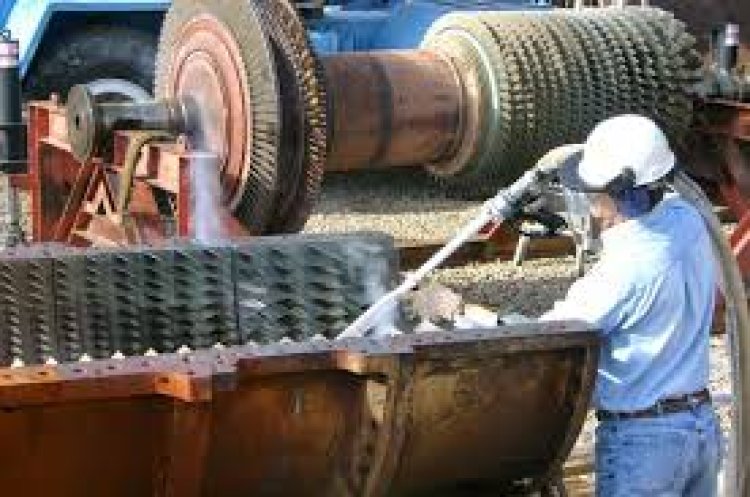Dry Ice Blasting: A Safe, Clean, and Eco-Friendly Cleaning Solution
Share this Post to earn Money ( Upto ₹100 per 1000 Views )

Dry Ice Blasting: A Safe, Clean, and Eco-Friendly Cleaning Solution
What is Dry Ice Blasting?
Dry ice blasting is a modern cleaning method that uses dry ice pellets—solid carbon dioxide (CO₂)—to clean surfaces without water, chemicals, or abrasives. These pellets are shot out at high speed using compressed air. When they hit the surface, they freeze the dirt or grease, crack it, and remove it, while the dry ice turns directly into gas. This process is called sublimation and leaves no residue behind.
Dry ice blasting is effective, safe, and environmentally friendly, making it popular across many industries, including food processing, automotive, electronics, and restoration.
How Dry Ice Blasting Works
Dry ice blasting involves three key cleaning effects:
-
Impact: The dry ice pellets hit the surface at high velocity, breaking away loose particles.
-
Freezing: The extreme cold (-78.5°C) causes grease or dirt to freeze and become brittle.
-
Sublimation: The dry ice turns into gas on contact, lifting the dirt without leaving waste.
This combination makes it powerful enough to clean tough grime but gentle enough not to damage surfaces.
Main Benefits of Dry Ice Blasting
Dry ice blasting offers many advantages compared to traditional cleaning methods:
1. No Water or Chemicals
It uses only dry ice and air. No water, soap, or chemicals are involved, making it perfect for cleaning electrical parts, food equipment, and sensitive machinery.
2. No Residue or Waste
Since dry ice turns into gas, it leaves nothing behind. This saves time, reduces waste disposal costs, and eliminates secondary cleaning.
3. Non-Abrasive
Unlike sandblasting, dry ice blasting is gentle. It doesn’t wear down or damage equipment, paint, or surfaces.
4. Environmentally Friendly
Dry ice is made from recycled CO₂, which doesn’t add harmful emissions. No toxic waste or pollutants are created during the process.
5. Less Downtime
In many cases, machines can be cleaned without being turned off or taken apart. This helps keep production running and reduces downtime.
Where Dry Ice Blasting is Used
Dry ice blasting is suitable for a wide range of industries and applications:
1. Food and Beverage Industry
-
Cleans ovens, mixers, conveyors, and packaging lines.
-
Meets food safety regulations—no risk of contamination.
-
Removes baked-on grease, sugar, and residues.
2. Automotive and Mechanical Maintenance
-
Removes oil, rust, paint, carbon deposits, and sealants.
-
Used in car restoration, detailing, and maintenance.
-
Cleans engines and mechanical parts safely and effectively.
3. Manufacturing and Industrial Cleaning
-
Cleans production machinery, molds, dies, and tools.
-
Safe for robotic equipment, hydraulics, and mechanical systems.
-
Helps reduce maintenance time and extend machine life.
4. Electronics and Electrical Equipment
-
Safe for motors, generators, circuit boards, and control panels.
-
Prevents electrical faults because no water or moisture is involved.
-
Removes dust, dirt, and carbon buildup.
5. Historical and Building Restoration
-
Removes mold, soot, smoke damage, and old paint.
-
Does not harm stone, wood, or brick.
-
Ideal for museums, churches, and heritage buildings.
Limitations of Dry Ice Blasting
Despite its many benefits, dry ice blasting may not be ideal for every situation. Some limitations include:
-
High Initial Cost: The machines and dry ice can be costly to purchase or rent.
-
Not Effective on Very Thick Coatings: Heavy rust, tar, or epoxy might require more aggressive cleaning.
-
Requires Proper Ventilation: As dry ice turns to CO₂ gas, good airflow is needed to keep the area safe.
-
Dry Ice Must Be Stored Correctly: It evaporates over time and must be used shortly after delivery.
Safety Tips for Dry Ice Blasting
Dry ice blasting is generally safe when proper guidelines are followed. Here are a few key safety tips:
-
Always wear protective gloves, goggles, and ear protection.
-
Use in well-ventilated areas to avoid CO₂ gas buildup.
-
Never touch dry ice with bare hands as it can cause cold burns.
-
Only trained personnel should operate blasting machines.
Dry ice blasting provides a perfect balance of safety, effectiveness, and sustainability, especially for modern industries.
Is Dry Ice Blasting Worth It?
Though the initial investment may be higher than other methods, dry ice blasting can save money in the long term. Businesses benefit from:
-
Lower maintenance costs
-
Reduced machine downtime
-
Cleaner work environments
-
Fewer chemical and waste disposal issues
Companies focused on safety, cleanliness, and eco-friendly practices often find dry ice blasting to be the best option.
Conclusion
Dry ice blasting is a powerful and environmentally responsible cleaning method. It’s dry, safe, and effective across many industries—from food processing to historic restoration. With no water, no residue, and no damage to surfaces, it offers a smart alternative to outdated cleaning techniques.
If your business requires fast, efficient, and chemical-free cleaning, dry ice blasting could be the perfect solution.

















